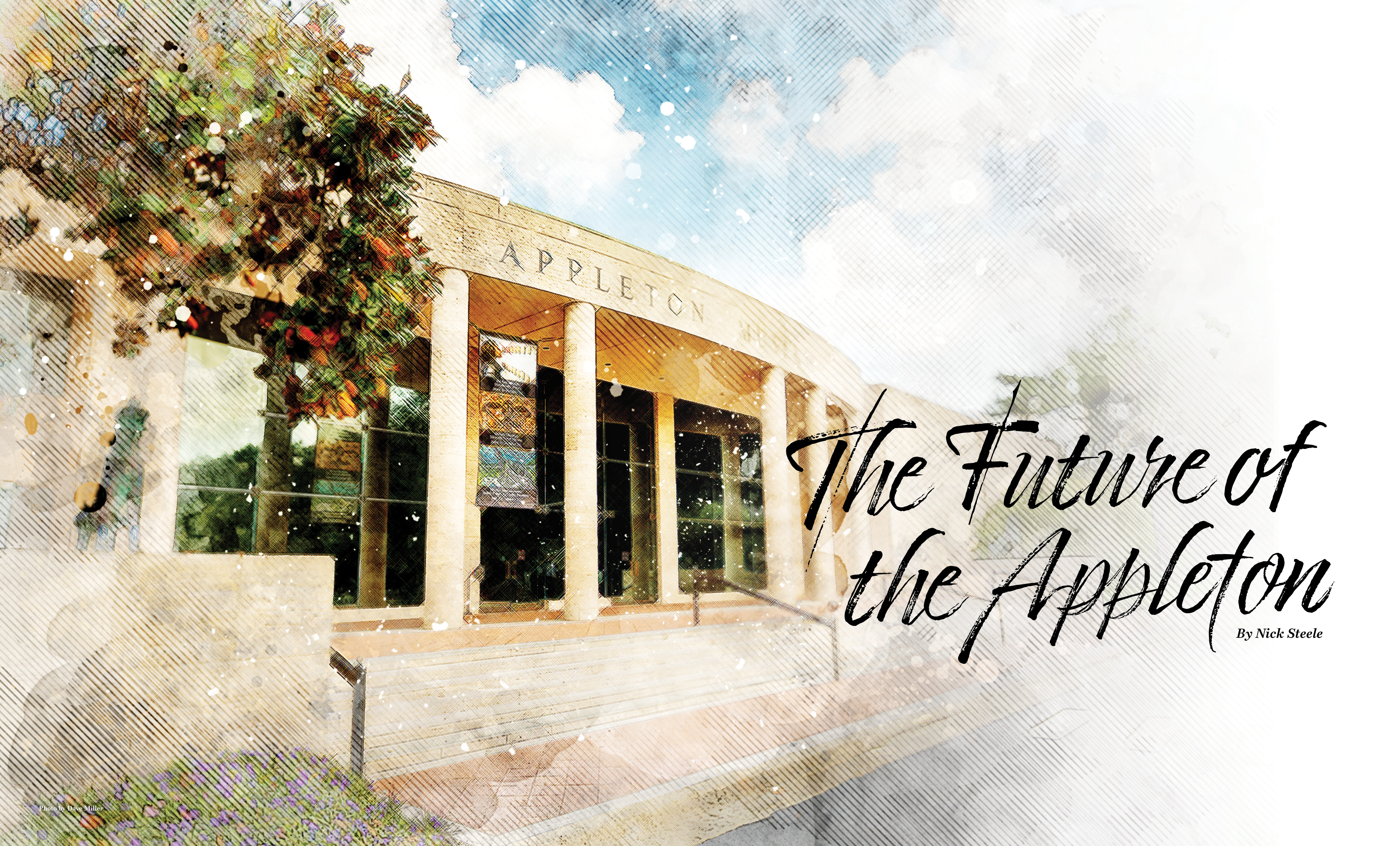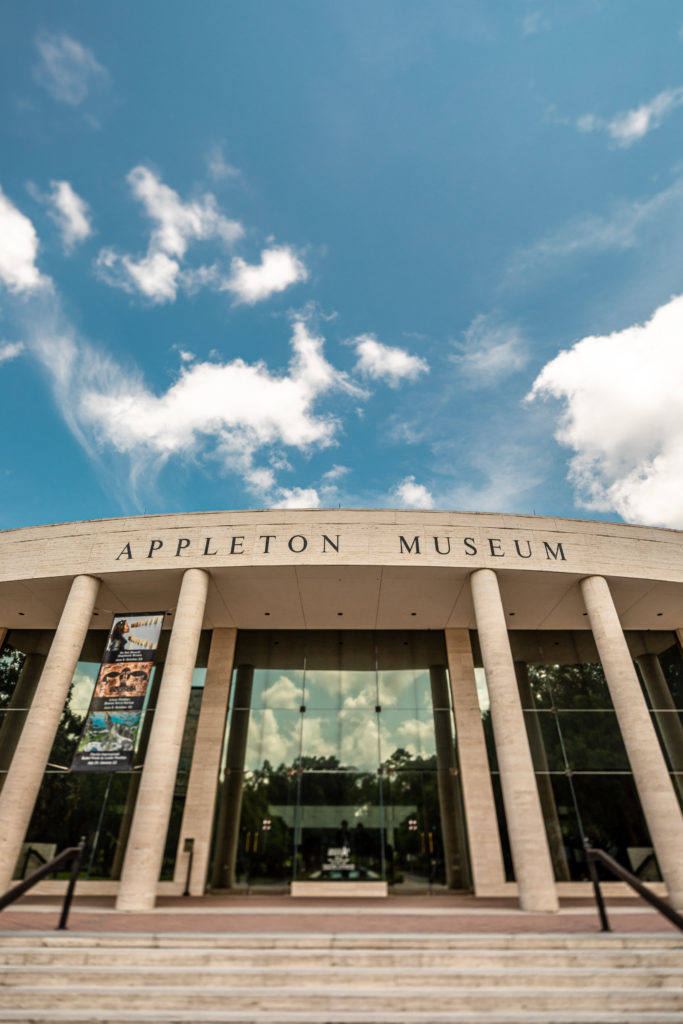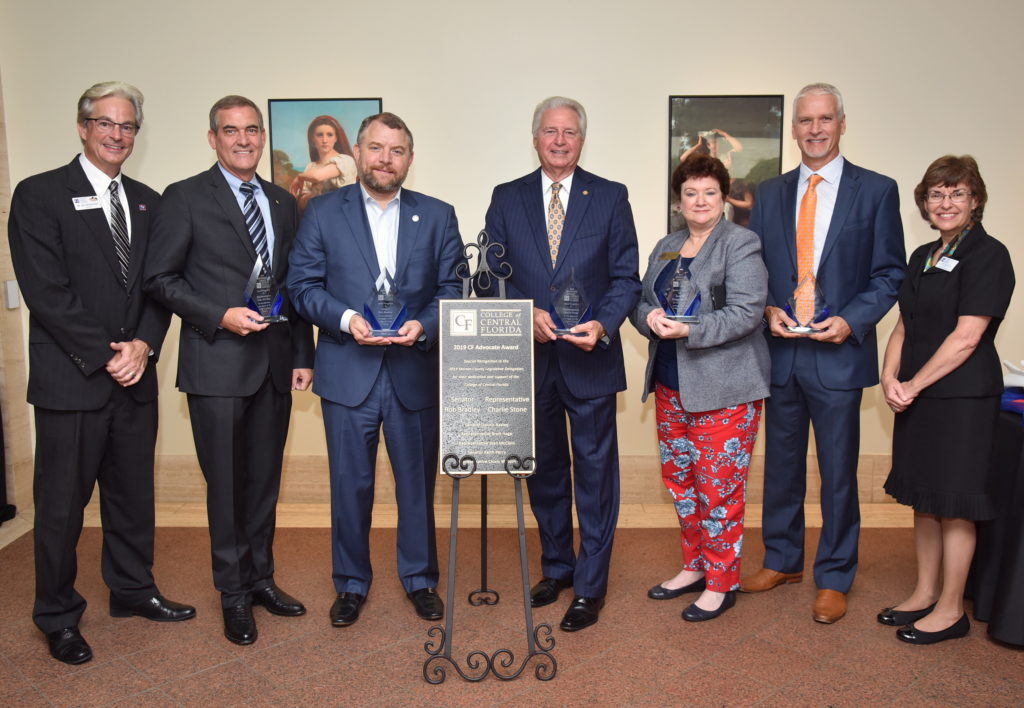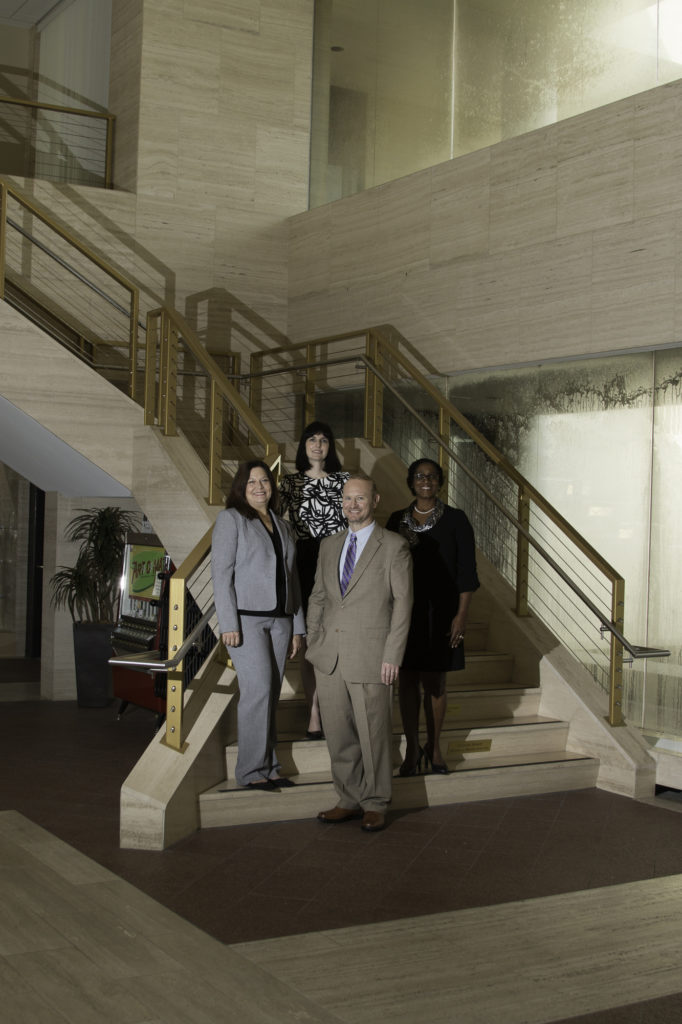
It is often referred to as a gem, couched in the words hidden or cultural—a sparkling, multi-faceted jewel right here in the heart of Ocala. But the Appleton Museum of Art, situated on 11.3 acres, may feel more like a temple of high culture to first-time visitors. The landscaped grounds and long reflecting pool naturally beckon one toward the museum’s elegant two-story Italian travertine marble façade.
The museum’s permanent collection contains about 18,000 objects, valued at between $40 million and $50 million dollars, although there are usually only about 1,300 on exhibit at any one time in the 30,000 square feet of gallery space devoted to the permanent collections. Among the masterworks owned by the museum are pieces by Alexander Calder, Robert Rauschenberg, Elizabeth Gardner, and Rodin. Over the years, works by such renowned artists as Picasso, Matisse, Rembrandt, Salvador Dali, Marc Chagall, van Gogh and Rubens have been a part of the Appleton’s exhibitions.
The museum earned the same level of accreditation as the Smithsonian in 2013 and has an esteemed new director starting this month. Jason Steuber, who most recently held the role of the Cofrin Curator of Asian Art Endowed Chair at the Samuel P. Harn Museum at the University of Florida in Gainesville, has more than 20 years of curatorial and project management experience and tremendous enthusiasm for the role he is stepping into. “There is an ordinary way to experience a museum and an extraordinary way,” Steuber asserts. “If you don’t get goose bumps at least once at the museum, we need to find something that is going to give you that goose bumps experience. As the director, I need to ensure that we are offering those types of moments.”
“There is an ordinary way to experience a museum and an extraordinary way,” Steuber asserts. “If you don’t get goose bumps at least once at the museum, we need to find something that is going to give you that goose bumps experience. As the director, I need to ensure that we are offering those types of moments.”
Steuber is just the latest addition to the talented leadership team, which includes Dr. Jillian Ramsammy, Vice President of Institutional Effectiveness and College Relations for the College of Central Florida (CF) which operates the museum; Curator of Exhibitions Patricia Tomlinson; and Assistant Director of Museum Operations Victoria Billig.
So with all that going for it, it may surprise you to learn how close this venerable institution recently came to closing its doors and selling off the treasures contained inside. We sat down with CF President Dr. James Henningsen to get some insight into that crisis as part of a series of articles we will be running on the future of the Appleton. But before we unwind that tangled tale—a history lesson.
“This is not some little museum around the corner,” CF President Dr. James Henningsen offers. “This museum could have been in Chicago or Washington. The museum is a treasure that could be in any city in this country.”
In fact, it almost was, Henningsen reveals. His eyes brighten as he shares a story he learned over lunch one day from “the gang of four” as they called themselves. “Mary Britt, rest her soul, said, ‘Jim, you need to meet the four guys who helped make this museum,’” he recalls. “So we had lunch. It was Jim Kirk, Doug Oswald, Dick Chazal and Jim Jernigan. They hadn’t all been together since they worked together on the museum. I really loved hearing the story of what they did back then.”
The story, taken from our own archives, revolves around a wealthy entrepreneur and “a klatch of Ocala hunting buddies” who hunkered down around a campfire near the Dove Creek Ranch outside Merchant, Texas. Jernigan, a prolific photographer who owned and operated his photo studio in Ocala for 69 years, recalled that Clyde Nix, who was Arthur Appleton’s farm manager, mentioned that his boss was looking for a place to house his extensive art collection.
“The Appleton family owned Appleton Electric in Chicago,” Henningsen explains about the enterprising clan that had amassed a fortune and held over 160 U.S. patents. “Arthur came down here and bought Bridlewood Farm and started raising thoroughbreds. He wanted to build a museum in Chicago to honor his dad and his family. He said, ‘I’ll build the building and I’ll put in all the artwork, but you have to call it the Appleton Museum of Art.’ And the folks in Chicago said, ‘No, we don’t name any museum anything other than the Chicago Museum of…’ So, the guys said, ‘You need to build it here, Arthur.’ They told him, ‘Look, the city will donate the land to build your museum out here. It’s a great area.’ And so, he did.”
The four men would become the nucleus of the Appleton’s first board of trustees. What they didn’t realize, according to Henningsen, was how much it was going to cost. “Mr. Appleton wanted only the top of the line for everything,” he says. “The building is a work of art on its own.”
They also realized that it was going to cost much more to operate it than they expected, Henningsen explains. “They created a $100,000 endowment, but they didn’t have any idea how much it was actually going to cost to run the museum. That’s when they started needing help. The college was connected from the get-go and we tried to help. We lobbied and got the initial state funding. We realized it needed a lot more,” he continues. “Jim Kirk was a big Florida State University (FSU) fan, which is how FSU got involved. They said, ‘We’d be interested.’ So FSU partnered with the CF and they helped us get a big state appropriation to fund the museum.”
The family then put more endowment money into the foundation, with specific guidelines that it only be used to support the museum. “FSU took ownership of that and we helped out to some degree, but it was FSU’s museum. They had the endowments, the state appropriation, and they were running it,” Henningsen explains. “They did that for a few years and then the family found out that they were spending the endowment on things other than the museum. There was a lawsuit in 2004 and part of the settlement was that the museum would be shifted to the College of Central Florida. The endowment was transferred from FSU’s foundation to ours. There was an operating agreement that FSU signed, the family signed, and we signed that binds us until 2035. It says that the state appropriation must be used on the museum. There is an executive committee and a legal agreement that covers that.”
It also stipulated that if for any reason the state appropriation was eliminated before 2015, that the two foundations were on the hook to fund the museum. But 2015 came and went without a problem. It was two years later that the museum fell into jeopardy.
“In 2017, the legislature decided to look at all special projects that were being funded anywhere in the state, colleges, universities, municipalities, anywhere,” Henningsen recalls. “This was because they’d heard that some of these projects, where they gave recurring dollars, didn’t even exist anymore. That line item transfer in 2004, of $1.3 million from FSU to us, came up in the legislature. After it was transferred to us, we had received an additional amount, which brought it up to just over $1.5 million. That was what was on the books,” he continues. “Everyone in The Florida House [of Representatives] got a group of items and someone from South Florida got that one. We spent a lot of time with the representative from South Florida, that was assigned to that line item and we convinced them to fund it. And they said, ‘All right, you are still using it. It is a state resource. It’s valuable…all good.’ The problem was that they moved the funding. They said, ‘Special Projects should not be a part of your college program fund.’ Every one of our twenty-eight public colleges get a line item for their mission; the same is true for universities. The museum was buried in that, so they took it out and made it a separate line item, but still funded it.”
 Once it was made a separate line item, however, then-Governor Scott vetoed it. “It had been funded for 20 years. So, he vetoed it and we lost the funding…in a shock,” Henningsen admits. “The museum was going to close its doors within three weeks. We had lost 75% of the operating funding. We had an operating cost of $1.9 million for the museum and had just lost $1.5 million of it. We found out in mid-June that the money would disappear on July 1st,” he continues. “Legally, I did not have access to money that could keep the Appleton open. We have an endowment of about $19 million, but that is the family endowment. The college did not have the authority to pull that level of funding out of the endowment to run the museum.”
Once it was made a separate line item, however, then-Governor Scott vetoed it. “It had been funded for 20 years. So, he vetoed it and we lost the funding…in a shock,” Henningsen admits. “The museum was going to close its doors within three weeks. We had lost 75% of the operating funding. We had an operating cost of $1.9 million for the museum and had just lost $1.5 million of it. We found out in mid-June that the money would disappear on July 1st,” he continues. “Legally, I did not have access to money that could keep the Appleton open. We have an endowment of about $19 million, but that is the family endowment. The college did not have the authority to pull that level of funding out of the endowment to run the museum.”
For anyone struggling to understand why the Appleton might need to close down with that kind of money at play, it helps to understand that endowment funds are given on the condition that the principal of the donation be kept intact and that only the investment income it produces be used to meet the museum’s needs. Typically, the endowment only pays out a small portion, about 4 to 5 percent per year to the museum. Endowment investments are designed to grow the principal and still generate some income.
Henningsen explains that the agreement the college had with the executive committee was to draw $500,000 a year to help fund the museum’s education programs and operating costs. The executive committee is comprised of college and foundation representatives, as well as Arthur Appleton’s daughter Linda Potter
“We reached out and said, ‘We’ve lost all the state funding to run this museum. We need access to the endowment.’ The family is very protective of the endowment and rightly so. It takes a lot of time to build up that level of endowment. And they want to protect it for the future of the museum,” he explains. “The family was very supportive and said that we had to keep the museum going. They gave us complete access to the endowment. We are very thankful they entrust us with the stewardship over the museum.”
With a temporary fix in place, Henningsen and his team set to work on a more lasting solution. “We realized that we needed to pull ourselves up by the bootstraps and fight to get our funding back. We talked to the county commissioners. We talked to the city council. We talked to the mayor, the county administrator, our legislative delegation…they all love the museum. They all knew what happened. We had all kinds of people reaching out to say, ‘What can we do to help?’ And there were some great ideas. But we had to develop a strategy to get back our $1.5 million a year, not $1.5 million just once, but every year.
“We struck out the first year,” he admits. “With the challenges our state has and a variety of different areas, across lots of fields, a museum doesn’t always come to the highest funding priority. You need the House, the Legislature and the governor’s office to all be on board. So we worked with our delegation members and they talked to the governor’s office, to make sure they knew what was going on too. We based our strategy on advocacy. We told our story. We got folks to come to the museum and see it, because when you see it you realize how special it is. The second year, it resonated with our delegation. I remember Senator Bradley, who has Levy County and the western part Marion County, said we need to fix this. He publicly said, ‘I really appreciate the fact that the college was able to keep these doors open while the state fell through on its commitment.’ Representative Stone said it was going to be one of his top priorities on the House side and Senator Bradley said I’m going to help any way I can. Senator Baxley was 100 percent behind us, as were Senator Perry and Representative McClain. We have a strong delegation. We had a small allocation early in the process for $200,000 as a line item. I was getting a little nervous and thought, It’s gonna take a little more than that, but whatever you can give us. By the end of session, the Legislature allocated $1.5 million recurring. That was a great step forward for us. Recurring means it’s in our base budget allocation again, just like it was before. Now there’s significant recurring funding that we can use toward the museum.”
 But does that mean that the Appleton’s budget woes are in the past? “Just because you got that much money before, does not mean you get it next year,” Henningsen explains. “It’s all at the discretion of the legislature of how they want to fund you. But it’s difficult to get recurring dollars added back into the budget when there’s so many other priorities, so I appreciate this support. Funding resources are tight, but you just have to keep pushing and believe it can happen. I’m thrilled. Now we just need to protect it and make sure it stays there.”
But does that mean that the Appleton’s budget woes are in the past? “Just because you got that much money before, does not mean you get it next year,” Henningsen explains. “It’s all at the discretion of the legislature of how they want to fund you. But it’s difficult to get recurring dollars added back into the budget when there’s so many other priorities, so I appreciate this support. Funding resources are tight, but you just have to keep pushing and believe it can happen. I’m thrilled. Now we just need to protect it and make sure it stays there.”
On August 13th, Henningsen hosted the delegation members at the Appleton and recognized their efforts with a plaque, bearing their names, that will hang in the museum’s courtyard in appreciation of their advocacy on behalf of the museum.
While the future is not set in stone…or even fine Italian marble, Henningsen, Steuber and the rest of the executive team are optimistic about what lies ahead and see the Appleton as a living, breathing, evolving organization with a renewed energy and a beating heart in the community.
“We get over 40,000 people coming through those doors every year,” Henningsen offers. “We’re believe that we’re among the top museums in the state. It’s a special place, we’re really proud of it and we’re just going to keep elevating what we do.”
Our exclusive coverage of the Appleton will continue in our October issue. For more information on the Appleton Museum of Art visit, www.appletonmuseum.org






